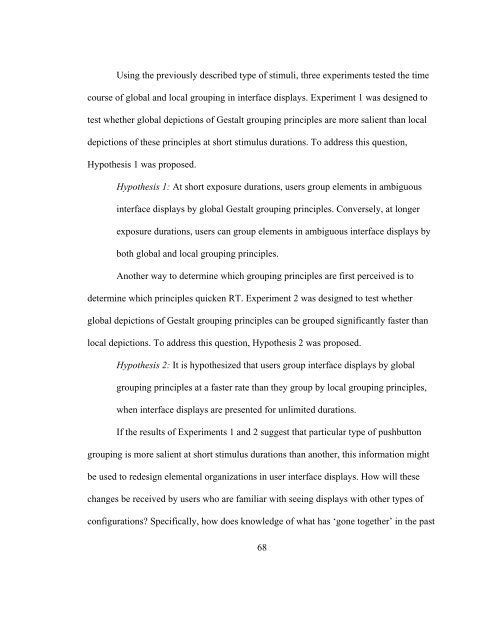The Use of Iambic Pentameter in the
The Use of Iambic Pentameter in the
The Use of Iambic Pentameter in the
Create successful ePaper yourself
Turn your PDF publications into a flip-book with our unique Google optimized e-Paper software.
Us<strong>in</strong>g <strong>the</strong> previously described type <strong>of</strong> stimuli, three experiments tested <strong>the</strong> time<br />
course <strong>of</strong> global and local group<strong>in</strong>g <strong>in</strong> <strong>in</strong>terface displays. Experiment 1 was designed to<br />
test whe<strong>the</strong>r global depictions <strong>of</strong> Gestalt group<strong>in</strong>g pr<strong>in</strong>ciples are more salient than local<br />
depictions <strong>of</strong> <strong>the</strong>se pr<strong>in</strong>ciples at short stimulus durations. To address this question,<br />
Hypo<strong>the</strong>sis 1 was proposed.<br />
Hypo<strong>the</strong>sis 1: At short exposure durations, users group elements <strong>in</strong> ambiguous<br />
<strong>in</strong>terface displays by global Gestalt group<strong>in</strong>g pr<strong>in</strong>ciples. Conversely, at longer<br />
exposure durations, users can group elements <strong>in</strong> ambiguous <strong>in</strong>terface displays by<br />
both global and local group<strong>in</strong>g pr<strong>in</strong>ciples.<br />
Ano<strong>the</strong>r way to determ<strong>in</strong>e which group<strong>in</strong>g pr<strong>in</strong>ciples are first perceived is to<br />
determ<strong>in</strong>e which pr<strong>in</strong>ciples quicken RT. Experiment 2 was designed to test whe<strong>the</strong>r<br />
global depictions <strong>of</strong> Gestalt group<strong>in</strong>g pr<strong>in</strong>ciples can be grouped significantly faster than<br />
local depictions. To address this question, Hypo<strong>the</strong>sis 2 was proposed.<br />
Hypo<strong>the</strong>sis 2: It is hypo<strong>the</strong>sized that users group <strong>in</strong>terface displays by global<br />
group<strong>in</strong>g pr<strong>in</strong>ciples at a faster rate than <strong>the</strong>y group by local group<strong>in</strong>g pr<strong>in</strong>ciples,<br />
when <strong>in</strong>terface displays are presented for unlimited durations.<br />
If <strong>the</strong> results <strong>of</strong> Experiments 1 and 2 suggest that particular type <strong>of</strong> pushbutton<br />
group<strong>in</strong>g is more salient at short stimulus durations than ano<strong>the</strong>r, this <strong>in</strong>formation might<br />
be used to redesign elemental organizations <strong>in</strong> user <strong>in</strong>terface displays. How will <strong>the</strong>se<br />
changes be received by users who are familiar with see<strong>in</strong>g displays with o<strong>the</strong>r types <strong>of</strong><br />
configurations? Specifically, how does knowledge <strong>of</strong> what has ‘gone toge<strong>the</strong>r’ <strong>in</strong> <strong>the</strong> past<br />
68

















